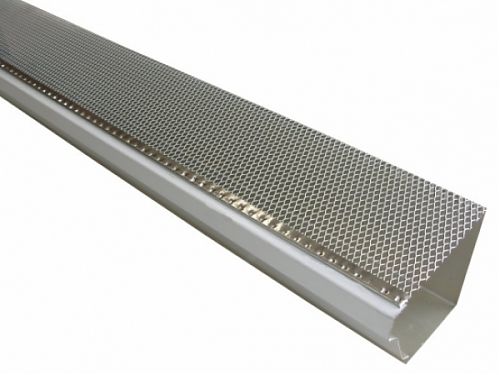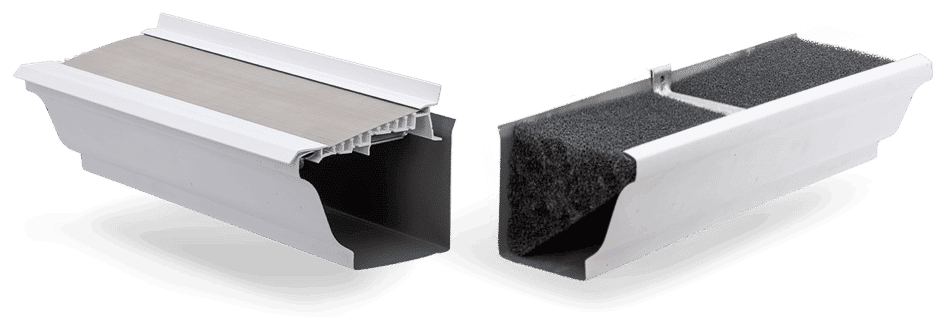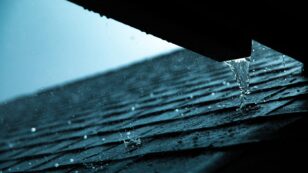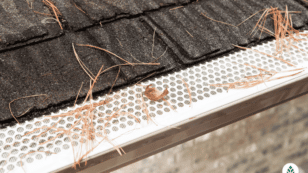

Types of Gutter Guards: A Homeowner’s Guide (2024)
In this guide on types of gutter guards, you’ll learn:
- What are the different types of gutter guards?
- How do the types of gutter guards work?
- What to consider when choosing a gutter guard?
- How do the different types compare to each other?
If you want to install gutter guards but aren’t sure which style to choose, this guide can ensure that you make the right decision for your home. Enter your zip code below to get a personalized quote on gutter guard options in your area.
Each product and or company featured here has been independently selected by the writer. You can learn more about our review methodology here. If you make a purchase using the links included, we may earn commission.
Gutters keep rainwater from falling directly next to your home, preventing foundation damage, leaking and other major issues that can be costly to repair.
Unfortunately, traditional gutters get clogged easily with tree and roof debris, causing blockages, improper drainage and potential damage to your soffits, fascia or roof.
Gutter guards — sometimes called leaf guards — are a simple and cost-effective solution for maintaining clean gutters, but there are multiple types to choose from that all come with different benefits and drawbacks.
In this gutter guard guide, we’ll take an in-depth look at the different types of gutter guards, how each works and how they stack up against each other in terms of performance and longevity.
What Are the Types of Gutter Guards?
Since gutter guards were invented, six different designs have become popularized. These include:
- Micro mesh gutter guards
- Mesh gutter guards
- Screen gutter guards
- Foam gutter guards
- Brush gutter guards
- Reverse curve/surface tension gutter guards
Below, we’ll explain how each works and help you decide which style of gutter guard is right for your home.
Gutter Guard Type Comparison
Here’s a quick overview of each type of gutter guard:
| Gutter Guard Style | Relative Price ($-$$$$) |
Ease of Installation | Durability | Efficiency (out of 5) |
| Micro mesh | $$$ | Difficult (professionals only) | Durable | 5 |
| Mesh | $$$ | Somewhat challenging (recommended for pros, but DIY is possible) | Durable | 4 |
| Screen | $$ | Somewhat challenging (recommended for pros, but DIY is possible) | Very durable | 4 |
| Foam | $ | Simple (professional or DIY is possible) | Least durable | 2 |
| Brush | $ | Simple (professional or DIY is possible) | Somewhat durable | 3 |
| Reverse curve/surface tension | $$$$ | Difficult (professionals only) | Durable | 4 |

LeafFilter

Save 12% plus $250 off on gutter guards for your home. Seniors and Military save an additional 10%.
Average cost
Pros
- Made from sustainable materials
- Materials are recyclable
- Positive customer reviews
- Has green initiatives
- Competitive pricing
Cons
- Not DIY-friendly

MasterShield

Get a free estimate today!
Average cost
Pros
- Made from sustainable and/or recycled materials
- Materials are recyclable
- Lifetime and/or comprehensive warranty
- Lots of color and design options
- Has green initiatives
Cons
- Expensive products or installation fees
- Reports of clogging
- Made of non-recyclable materials
- Not DIY-friendly

HomeCraft

New customers save 30%.
Average cost
Pros
- Offers pitched/diamond designs for better flow
Cons
- No stated commitment to bettering the environment
- Some negative online reviews
- Limited availability
Check out this helpful video to learn more about the various types of gutter guards:
Micro Mesh

Micro mesh gutter guard systems are a type of screen guard, but the holes that allow water to flow through are, as the name suggests, quite small.
This type of guard is the best for preventing debris from entering your gutters, from large debris like sticks and leaves to small debris like roof shingle pieces and pollen.
Micro mesh guards do have a slow diffusion rate, meaning they can sometimes get overwhelmed by downpours. Although this is rare, this style isn’t always ideal for climates with heavy rain.
These guards are typically made out of corrosion-resistant metals and are supported by polyvinyl chloride (PVC) or aluminum frames. Both PVC and aluminum gutter guard frames have stainless steel micro mesh screens on top that are extremely durable and often come with a lifetime warranty.
Unfortunately, the installation process can be a bit challenging, so it’s recommended only for professionals. This will drive up your gutter installation cost, but you’ll also be left with properly functioning rain gutter guards that will last a lifetime.
Micro mesh guards are on the expensive side, but again, they offer the best protection and require the least cleaning.
Pros
- Highly efficient
- Very durable
- Comes with a lengthy warranty
- Minimal cleaning required
- Typically made of recyclable materials
Cons
- Must be installed by professionals
- More costly than many other styles
Mesh

Mesh gutter guards, another subtype of screen gutter guards, act similarly to the micro mesh style. Mesh guards have larger holes than micro mesh guards, so they’re a bit easier to manufacture and are often less expensive.
The screen holes are larger in mesh gutter guards than micro mesh, allowing water to flow through at a slightly faster rate. This lowers the chance of water building up on top of them in the case of heavy rain, but it also means small types of debris — like pieces of leaves and pollen — can make their way through.
As such, mesh gutter guards are slightly less effective than micro mesh options, and they will require more regular cleaning. One advantage of mesh over micro mesh is the installation process. Although it’s recommended for professionals, experienced DIYers can do it to save some money.
Pros
- Can be installed as a DIY project, although it’s challenging
- Can withstand heavy rain
- Very durable
- Minimal cleaning required
- Made of recyclable materials
Cons
- On the expensive side
- Usually requires professional installations
Screen

Screen gutter guards are any type of guard that uses a screen — like a window screen — to prevent debris buildup while still allowing water to flow through.
Micro mesh and mesh gutter guards are both types of screen guards, but the term “screen gutter guards” usually refers to guards that have larger holes than these subtypes.
Screen gutter guards usually have very good flow rates for water, and they’re great for stopping larger debris — like sticks, leaves, pine needles and acorns — from clogging your gutters.
However, smaller debris — like pollen and roof pieces — can still work their way through the screen. Screen gutter guards typically require gutter cleaning two times a year.
This style is quite durable and affordable, especially if you opt for a DIY gutter guard installation. It’s still better for professionals to handle installing these guards, but it’s possible to buy them from Home Depot or Amazon and install them yourself.
Pros
- Relatively affordable
- Can be installed as a DIY home improvement project
- Provide great flow rate for heavy rain
- Reasonably effective at trapping large debris
- Typically made of recyclable materials
Cons
- Lets smaller debris through
- Requires more cleaning than micro mesh and mesh guards
Foam

Foam gutter guards are, as the name suggests, made of foam. This is both a good and bad thing, as they’re exceptionally affordable and ideal for DIY installers, but they are also the least durable style.
This also makes foam gutter guards the least eco-friendly type, as they require frequent replacement and are difficult to recycle.
Foam gutter guards are usually designed to fit into the most common gutter sizes and shapes, like 5-inch gutters and k-style gutters. They’re great for blocking mostly large debris from getting into your existing gutters and downspouts.
The major downsides of foam gutter guards include the lack of durability and how often they clog. You’ll likely find yourself removing them, cleaning your gutters, rinsing the foam and replacing the guards at least twice a year — probably about once a season.
As such, they’re not the best option for homeowners looking for eco-friendly options or products with minimal maintenance.
Pros
- Very affordable
- Easy to install for DIYers
- Reasonably good at blocking large debris
Cons
- Allows smaller debris to enter your gutters
- Least durable style
- Requires regular and somewhat intensive cleaning
- Least environmentally friendly type
Brush

Brush gutter guards look like large pipe cleaners that you place in your gutters. The bristles are rigid and extend in a circular pattern, so they allow water to pass through while stopping most large debris from entering your downspouts.
Brush gutter guards are very simple to install, so any homeowner should be able to tackle the project. These guards are slightly more costly than foam ones, but you can still save by installing them yourself.
Although brush guards are more durable than foam gutter guards, they still require replacement every few years.
The other primary downside to the brush style is the cleaning process. Large debris can easily get trapped between the bristles, which makes cleaning somewhat time-consuming.
The process is simple — just remove the brush, clean the bristles, clean the gutters and replace — but you’ll spend more time with the process than you would with most other styles.
Pros
- Affordable
- Easy to install for DIYers
- Fits most gutter styles and sizes
Cons
- Not the best in terms of efficiency
- Cleaning can be frustrating and time-consuming
- Replacement required every few years
Reverse Curve / Surface Tension
Courtesy: E-Z Gutter Guards
Reverse curve gutter guards work by introducing a solid plane or mesh over the gutter, which then cuts back under itself toward the bottom of the gutter. The plane is pitched to match the angle of the roof, so debris can flow right off of the roof, and the water’s surface tension will cause it to drip back down the curve and into your gutter.
This style is reasonably effective and significantly reduces the frequency with which your gutters need to be cleaned. The exact level of efficiency depends, in part, on the size of the mesh.
These gutter guards are the most costly, and they require a professional gutter guard installation. They can also void your roof warranty in some cases, as your roof shingles need to be lifted for proper installation.
Pros
- Great for limiting debris that enters your gutters
- Requires minimal gutter cleaning
- Durable and usually comes with a lengthy warranty
- Requires a professional installation
Cons
- Might void your roof warranty
- Expensive
How to Choose the Right Type of Gutter Guard for You
One of the most crucial things to think about when installing gutter guards is what type suits your budget, preference and skill level, especially if you’re considering a DIY installation. Below, we’ll discuss some of the factors that can help decide which style is right for your home.
Cost
Price will always be something to consider when installing gutter guards. The different styles we’ve mentioned above can range from around $4 per linear foot to over $15 per linear foot, so your budget can be a major determining factor in which styles are available to you.
Generally speaking, more costly styles will provide better protection and require less frequent gutter cleaning. If you’re looking for mild protection at a low cost, foam or brush gutter guards are probably best for you.
If the price is no issue and you simply want the ideal gutter guard protection from debris and clogs, micro mesh and reverse-curve gutter guards are probably your best options. Mesh and screen gutter covers are also available for those looking to balance efficiency, cost and the frequency of cleaning.
It’s worth mentioning here that if you’re planning on installing new gutters and don’t have existing hangers in place, DIY installation is not recommended.
You can also save quite a bit of money having a professional install your gutter guards along with new gutters.
Level of Maintenance Required
Installation is one thing, but the regular maintenance required to take care of your gutters is another. For a gutter to work properly, it cannot be clogged or stuffed with debris. Some gutters need to be cleaned more regularly than others, so homeowners should take this into account before they choose a gutter style.
Foam and brush gutters require regular cleaning to function properly, and this cleaning is not easy. To clean these gutters, you’ll need to take them apart and clean off individual parts. Not only is this time consuming, but it can be incredibly frustrating.
Mesh and micro mesh gutters, on the other hand, require the least maintenance, which is why these types of gutters have become increasingly popular.
Curb Appeal
Many homeowners neglect to consider the curb appeal of their gutter guards and are sometimes disappointed to find that they have spent money to make their homes less appealing.
Many styles will be visible from the street and your yard. If you want gutter protection that isn’t visible at all, foam guards and some brush guards will be best.
For screen guards — including mesh and micro mesh gutter guards — and surface-tension guards to work properly, they need to be angled above your gutters to line up with your roof.
They will be visible from the ground, although in many cases, they can be made to match your gutter material and color for a seamless appearance.
Installation
Finally, you should consider the installation process that each type of gutter guard requires.
Whether the specific style is suitable for DIYers or professionals will not only determine the cost of installation for gutter guards but also how quickly you can get your gutter protection set up.
Foam and brush-style gutter guards are suitable for any DIYer, provided you’re comfortable getting up on a ladder or your roof.
Mesh and screen gutter guards can be installed by experienced DIYers and professionals, and micro mesh and reverse-curve gutter guards should only ever be installed by professionals.
A general rule of thumb is the harder a gutter guard is to install, the more likely it is to maximize protection from debris and minimize ongoing maintenance.
Final Thoughts on the Types of Gutter Guards
Properly functioning gutters are crucial for protecting your home’s foundation from leaks and structural damage. Gutters can easily become clogged with tree and roof debris, causing blockages, leaks and other unwanted issues.
As such, gutter guards are a critical part of your gutter system; they help maintain proper drainage, minimize clogging and eliminate the need for cleaning.
There are six different types of gutter guards available for residential purposes: micro mesh, mesh, screen, foam, brush and reverse-curve. Each comes with its upsides and downsides, including varying prices, the ease of installation, how effective it is at screening debris and how often they need to be cleaned and serviced.
If making the sustainable choice for your home is the most important factor to you, we recommend investing in the most durable gutter protection that your budget comfortably allows.
Long-lasting options like micro mesh eliminate the waste that comes with replacement guards and are also the most likely to be recyclable.
Choosing the right gutter guards for your home will minimize your costs and provide you with the protection you need to reduce the frequency of professional gutter service.
FAQ: Types of Gutter Guards
Below, we’ll answer some of the most common questions we see from homeowners regarding the different styles of gutter guards.
This question is difficult to answer without some additional information about your budget and your home.
If you’re looking to minimize the cost and don’t mind cleaning your gutters a few times a year, foam gutter guards or brush gutter guards might be best for you.
If you instead want the most efficient gutter guards, don’t want to have to clean your gutters often and don’t mind paying a premium for high-quality equipment, micro mesh and reverse-curve gutter guards are probably best for you.
Other homeowners looking for a balance between cost and efficiency might be best served by mesh or screen gutter guards.
Yes, absolutely. Any type of gutter guard will help prevent clogs in your gutters and downspouts, which reduces the frequency with which you need gutter cleaning and improves the overall performance of your gutters.
With that being said, not all gutter guard styles are equal. Foam and brush guards will help keep large debris out of your gutters but will require more frequent and more time-intensive cleaning than other styles.
Screen and mesh guards will keep most debris out of your gutters and tend to require maintenance just two to four times a year.
Micro mesh and reverse-curve guards are the most effective and can virtually eliminate the debris that gets into your gutters. These styles usually only require one to two cleanings per year.
Most homeowners find that gutter guards are well worth the money, but of course, it depends on where you live and your willingness to clean your gutters.
If you have no problem getting up on a ladder and scraping leaves, sticks, roof pieces and other debris out of your gutters a few times a year, then gutter guards might not be worth it for you. If you don’t enjoy the cleaning process or want to save money on professional gutter cleaning services, then gutter guards will serve you well.
If you normally pay for annual gutter cleaning, gutter guards would likely pay for themselves within a few years.
Additionally, gutter guards are more valuable to homeowners who live near trees. Most of what causes gutter clogs and blockages is tree debris, so if there are no trees within a hundred feet or so of your home, gutter guards might not be worth it for you.

 233k
233k  41k
41k  Subscribe
Subscribe 













